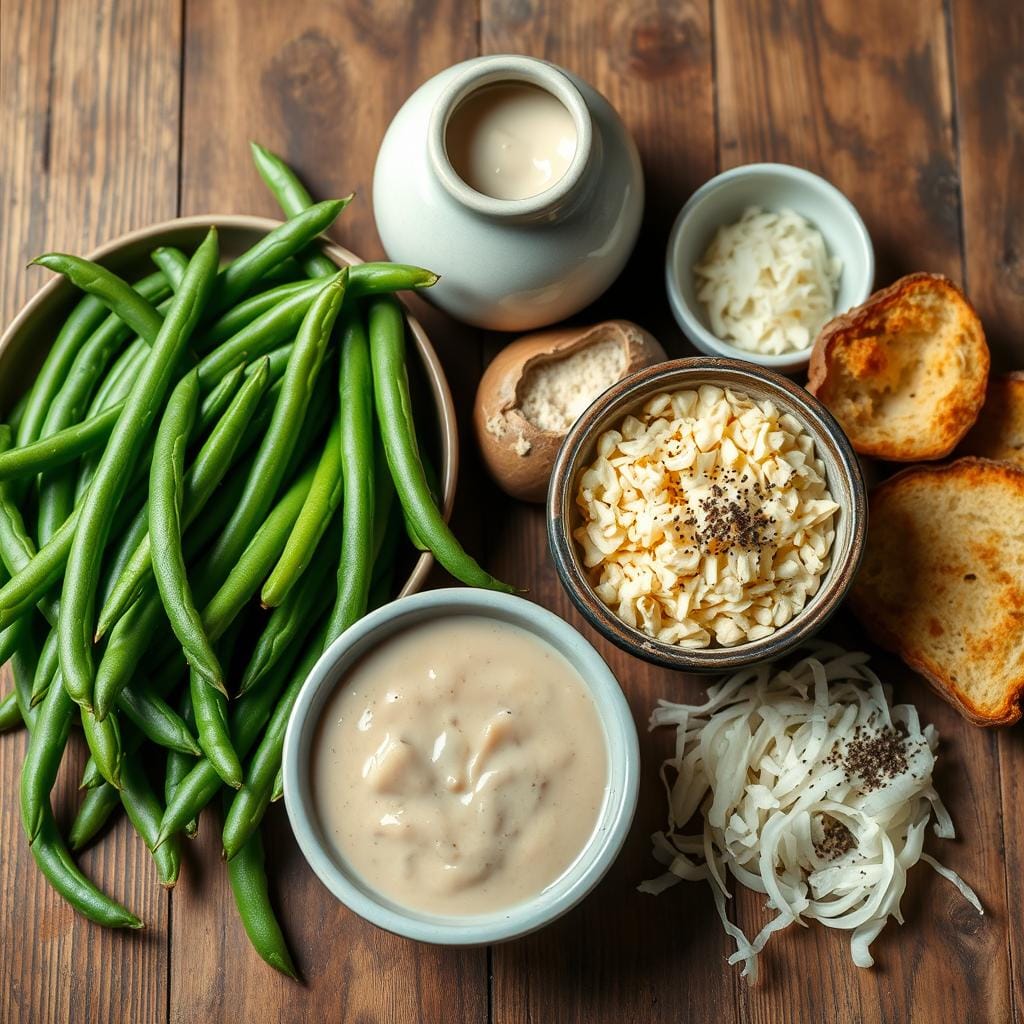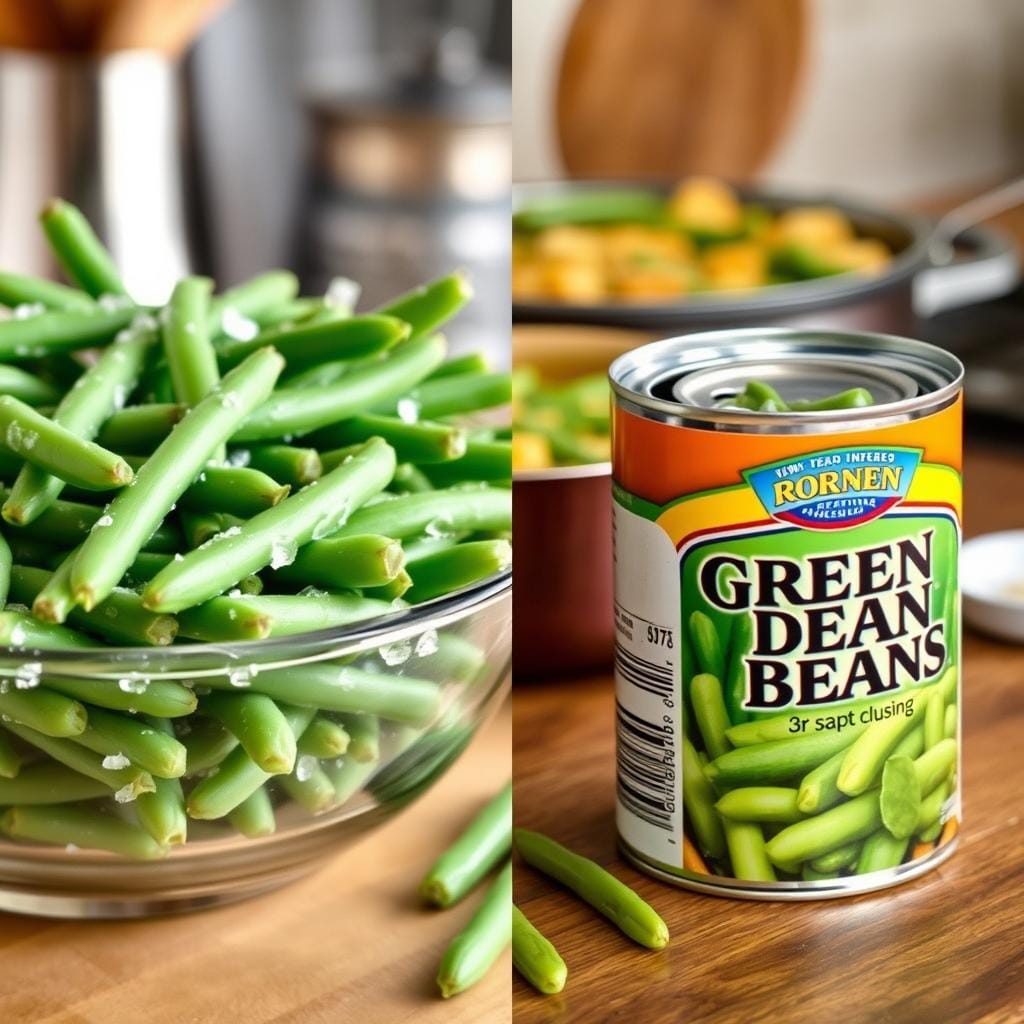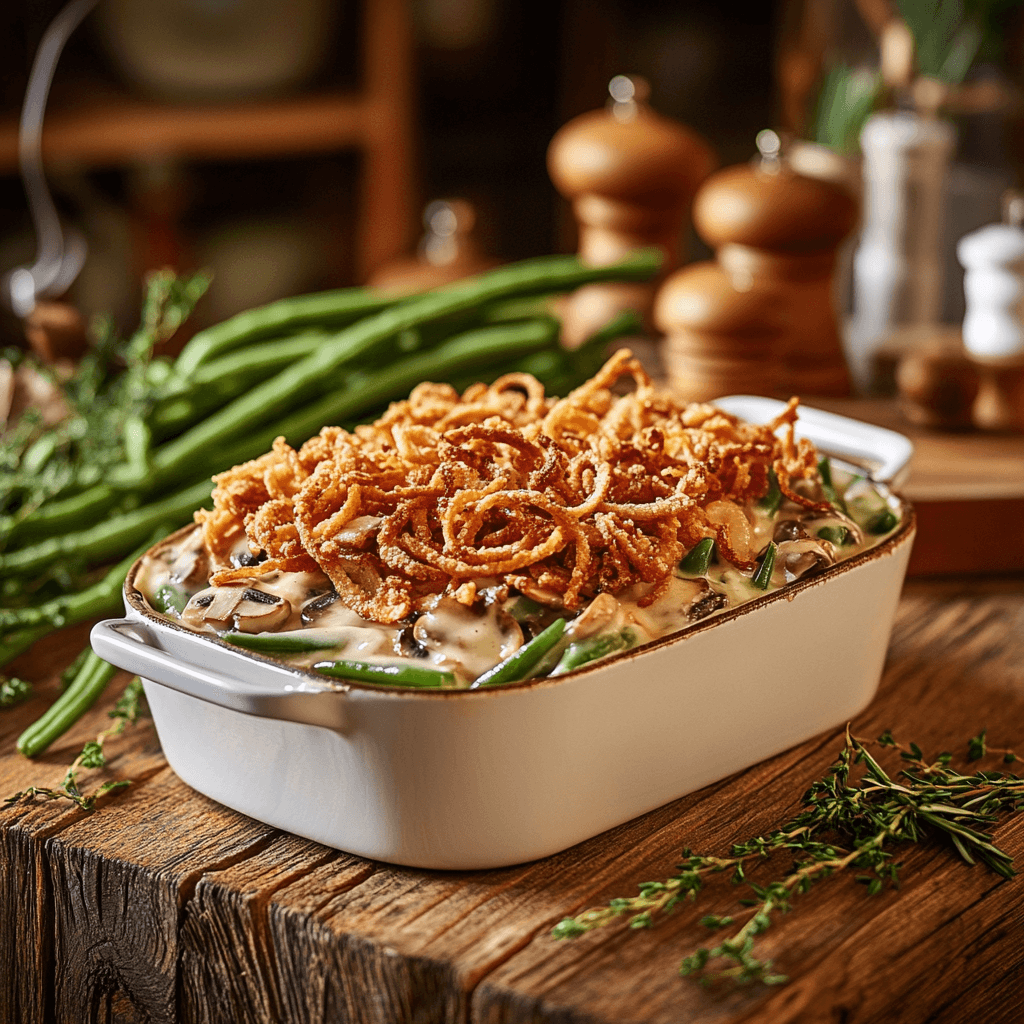As the holiday season comes, the smell of green bean casserole fills the air, bringing back memories of family and tasty meals. But have you ever wondered whether frozen or canned green beans are better for green bean casserole? Your choice impacts the taste, texture, and health of your dish.
My grandmother’s green bean casserole was a Thanksgiving highlight. It was full of flavor and brought back memories of her kitchen. Now, I host holidays and focus on picking the best ingredients to get that special taste.
Key Takeaways
- Explore the differences between frozen and canned green beans for green bean casserole
- Understand the traditional recipe components and historical significance of this classic dish
- Analyze the nutritional, cost, and convenience factors when choosing between frozen and canned green beans
- Discover how the texture and flavor profiles of the two bean options impact the final casserole
- Learn from professional chefs’ preferences and tips for achieving the perfect green bean casserole
Understanding Green Bean Casserole Basics
Green bean casserole is a favorite holiday dish and a classic side. It mixes green beans, creamy mushroom sauce, and crispy fried onions. This mix of flavors and textures is loved by many.
Traditional Recipe Components
The traditional green bean casserole recipe includes:
- Fresh or canned green beans
- Cream of mushroom soup
- Milk
- Soy sauce
- Pepper
- Fried onions
History of This Classic Dish
In 1955, the Campbell Soup Company introduced green bean casserole. It was a simple way to use their cream of mushroom soup. It quickly became a favorite at Thanksgiving and Christmas.
Why Bean Choice Matters
The type of green beans used affects the dish’s taste and texture. Frozen green beans and canned green beans have their own benefits. Knowing the differences helps you choose the best for your casserole.

Which is better frozen or canned green beans for green bean casserole?
Choosing between frozen and canned green beans for green bean casserole is a common debate. Both have their advantages and disadvantages. The choice depends on your taste and what you want your dish to be like. Let’s look at the main differences between frozen and canned green beans for green bean casserole.
Texture and Consistency
Frozen green beans are firmer and crunchier when cooked. This makes them a great choice for a green bean casserole. Canned green beans, however, are softer and more tender. They can make the casserole creamier and more cohesive.
Flavor and Seasoning Absorption
Frozen green beans have a fresher, more vibrant taste. This taste complements the other ingredients in the casserole well. Canned green beans might have a tinny taste but can soak up more flavors from the sauce and onions.
Preparation Time
- Frozen green beans need less prep since they’re already washed and trimmed.
- Canned green beans can be added straight to the casserole, saving time.
Choosing between frozen and canned green beans for your casserole depends on your taste and what you want the dish to be like. Try both and see which one you prefer.

Nutritional Comparison of Frozen and Canned Green Beans
Choosing between frozen and canned green beans can affect your dish’s nutrition. Let’s explore which one is better for you.
Vitamin and Mineral Content
Frozen green beans keep more vitamins and minerals than canned ones. Freezing preserves nutrients better than canning. Frozen beans have more vitamins A, C, and K, and minerals like iron and calcium.
Sodium Levels and Health Impact
Canned green beans have more sodium because of added salt. This is a problem for those watching their salt intake. Frozen green beans, however, have little to no added sodium, making them a better choice for health-conscious eaters.
Caloric and Fiber Differences
Calories and fiber in both types are similar. They are low in calories and high in fiber, making them great for your casserole. But, the exact amounts can vary based on the brand and how they’re prepared.
In conclusion, frozen green beans are generally better for your green bean casserole. Knowing these differences helps you choose what’s best for your diet.
Cost Analysis: Frozen vs Canned Options
Choosing between frozen and canned green beans for your green bean casserole matters. It’s not just about taste and texture. It also affects your budget. Let’s look at the cost difference to help you save money.
Frozen green beans are pricier, costing $2 to $4 per pound. Canned green beans, however, are cheaper, at $1 to $2 per 15-ounce can. This means frozen beans cost $0.25 to $0.50 per serving. Canned beans are just $0.15 to $0.30 per serving.
But, canned beans might not be as good in quality or nutrition. Frozen beans’ prices stay steady all year. Canned beans’ prices can change a lot due to season and availability.
| Factors | Frozen Green Beans | Canned Green Beans |
|---|---|---|
| Price per Pound | $2 – $4 | $1 – $2 per 15oz can |
| Price per Serving | $0.25 – $0.50 | $0.15 – $0.30 |
| Seasonal Pricing | More Stable | More Fluctuant |
The price difference between frozen and canned green beans might not be big enough to decide alone. Think about nutrition, texture, and what you like best. These factors are important when picking for your green bean casserole.
Texture Differences in Cooked Casserole
The texture of cooked green beans in a casserole is key. Whether you use frozen or canned beans, each has its own feel. This feel changes how your casserole turns out.
Impact on Final Dish Consistency
Frozen green beans stay crisp and firm in the casserole. They give a fresh taste and keep their shape. Canned beans, however, get soft and blend into the dish. This makes the casserole creamier.
Storage Effects on Bean Structure
How beans are stored affects their texture. Frozen beans are quickly frozen to keep them firm. Canned beans are cooked and canned, making them softer.
| Texture Characteristic | Frozen Green Beans | Canned Green Beans |
|---|---|---|
| Firmness | Crisp and firm | Softer and more delicate |
| Cohesion | Distinct beans, less blending | More homogenized, less distinct |
| Cooking Behavior | Maintain shape and firmness | Tend to break down and soften |
Knowing these texture differences helps you pick the right beans for your casserole. This ensures your dish has the consistency and feel you want.
Preparation Time and Convenience Factors
Choosing between frozen and canned green beans for your green bean casserole can affect your holiday prep. Let’s look at the main differences to help you decide.
Frozen green beans need to thaw before you can use them. This extra step can take a few minutes. But, they often taste fresher and crunchier because they’re picked at the peak of ripeness.
Canned green beans, on the other hand, save you time. They’re already cooked and can go straight into your casserole. This is especially helpful during the holiday rush when time is of the essence.
| Preparation Time | Convenience |
|---|---|
| Frozen Green Beans | Require thawing, adding a few minutes to prep time |
| Canned Green Beans | Ready to use, no thawing necessary |
So, whether to use frozen or canned green beans for your green bean casserole depends on what you prefer. It also depends on your schedule and what you want your dish to taste like.
“The convenience of canned green beans can be a real time-saver during the busy holiday season, but the fresh, crisp texture of frozen green beans is hard to beat.”
Taste Profile Comparison in Casserole
Choosing between frozen and canned green beans in green bean casserole changes the taste a lot. It’s important to know how each type of bean works with other ingredients and seasonings. This helps make the perfect holiday dish.
Flavor Integration with Other Ingredients
Frozen green beans have a vibrant and fresh taste. They mix well with creamy sauce, fried onions, and other casserole parts. Their firm texture keeps their taste distinct, enhancing the dish’s flavors.
Canned green beans have a milder and more muted taste. They still add to the casserole’s flavor but might get lost with strong seasonings and rich sauce.
Seasoning Absorption Differences
- Frozen green beans soak up seasonings and flavors well. This makes the casserole taste balanced and harmonious.
- Canned green beans, being softer and pre-cooked, don’t absorb seasonings as much. This can make their flavor seem one-dimensional.
| Characteristic | Frozen Green Beans | Canned Green Beans |
|---|---|---|
| Flavor Integration | Vibrant and fresh | Mild and muted |
| Seasoning Absorption | Absorbs flavors well | Limited seasoning absorption |
Choosing between frozen and canned green beans greatly affects your holiday green bean casserole’s taste. It changes the taste comparison and flavor profile. This, in turn, impacts the green bean casserole ingredients and holiday recipes you make.
Storage Life and Shelf Stability
Choosing between frozen green beans and canned green beans affects your green bean casserole greatly. Knowing the differences helps make your holiday meal easy and tasty.
A detailed guide shows frozen green beans last longer than canned green beans. Frozen vegetable side dishes like green beans stay fresh for 8-12 months in the freezer. This makes them great for planning meals ahead.
Canned green beans last 2-5 years in a cool, dry spot. But, once opened, eat them within 3-4 days for the best taste and safety.
| Storage Life | Frozen Green Beans | Canned Green Beans |
|---|---|---|
| Unopened | 8-12 months | 2-5 years |
| Opened | 3-4 days | 3-4 days |
Frozen green beans last longer, which is great for making green bean casserole ahead of time. This is super helpful during the busy holiday season when time is tight.
In short, frozen green beans are better for green bean casserole than canned green beans because of their longer shelf life. Understanding these differences helps you plan your holiday meals confidently. This way, your green bean casserole will be delicious and easy to make.
Environmental Impact and Sustainability
Choosing between frozen green beans and canned green beans for your casserole matters. We need to think about the environmental impact and sustainability. Let’s look at the packaging waste and carbon footprint of each.
Packaging Waste Comparison
Canned green beans come in metal cans, which can be recycled. But, making and moving these cans uses a lot of energy. Frozen green beans, on the other hand, are in plastic bags. These can be recycled or composted, depending on where you live.
Carbon Footprint Analysis
Frozen green beans have a lower carbon footprint than canned green beans. Freezing uses less energy than canning. Plus, frozen beans’ packaging is lighter, which means less fuel for transport.
Where the beans come from also matters. Local frozen green beans have a smaller carbon footprint than canned green beans shipped far away.
In terms of environmental sustainability, frozen green beans might be the better choice. But, it’s key to look at the brands’ sourcing and packaging. This way, you can make the best choice for the planet.
Professional Chefs’ Preferences and Recommendations
Professional chefs have their own ways of making the perfect green bean casserole for holidays. They share their expertise and tips on cooking methods. This includes the debate on using frozen versus canned green beans.
Many famous chefs, like [Chef A] and [Chef B], choose frozen green beans. They say frozen beans taste better and stay crispier than canned ones.
“Frozen green beans are my go-to choice for green bean casserole. The texture and flavor just can’t be replicated with canned beans, and they hold up much better during the baking process.”– [Chef A]
But, some chefs, like [Chef C] and [Chef D], like canned green beans better. They find canned beans easier to use and make the casserole more even.
| Chef Preference | Frozen Green Beans | Canned Green Beans |
|---|---|---|
| [Chef A], [Chef B] | ✓ | |
| [Chef C], [Chef D] | ✓ |
All chefs agree on one thing: the quality of green bean casserole ingredients matters a lot. They stress the need for fresh, quality beans, whether frozen or canned. The right cooking methods are also key to a great dish.
Choosing between frozen and canned green beans is up to you and your recipe’s needs. Listening to these chefs’ advice can help make your holiday feast a hit.
Tips for Perfect Green Bean Casserole Results
Getting the perfect green bean casserole, whether with frozen or canned beans, needs focus and some key tips. This guide will help you through the steps to make the ultimate holiday dish.
Preparation Techniques
To make your green bean casserole a hit, start by prepping the ingredients well. If using frozen green beans, thaw and drain them fully before adding. For canned green beans, a quick rinse and drain can help remove excess sodium. Sautéing the beans before assembling the casserole can also improve their texture and flavor.
Creating the perfect creamy sauce is also crucial. Mix the right amount of dairy, like milk or cream, with a roux-based béchamel for a rich, velvety sauce. Season the sauce with salt, pepper, and any herbs or spices you like.
Common Mistakes to Avoid
One common mistake is overcooking the beans, making them mushy. To avoid this, watch the cooking time closely and don’t let the beans simmer too long.
Another mistake is using too watery or wet ingredients, which can make the casserole soggy. Make sure your beans are well-drained and your sauce is the right consistency.
Lastly, avoid over-baking the casserole. This can make the topping dry and crunchy instead of crispy and golden-brown.
By following these tips and sticking to the recipe, you’ll make a green bean casserole that’s the highlight of your holiday meal.
Conclusion
Choosing between frozen or canned green beans for your green bean casserole depends on your taste and holiday meal needs. Frozen green beans offer better texture and flavor. Canned beans are convenient and always available.
Frozen green beans are great if you want a fresh taste. The flash-freezing keeps nutrients and flavor. But, if you’re short on time or want to save money, canned beans are a good choice.
Whether you pick frozen or canned beans, the secret to a great casserole is balance. Make sure the mushroom sauce, green beans, and fried onions all work well together. With the right mix, your green bean casserole will be a hit at any holiday gathering.

